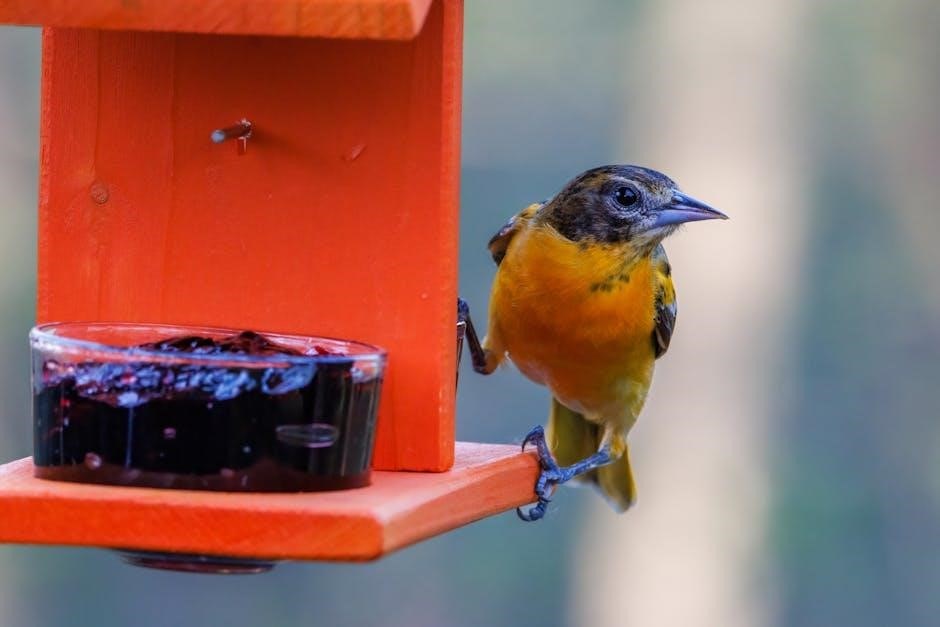This manual provides essential guidance for setting up and operating the American Hunter Feeder, emphasizing programmable timers, solar options, and sensor features for efficient wildlife feeding.
Overview of the American Hunter Feeder
The American Hunter Feeder is a durable, high-capacity wildlife feeding system designed for hunters and wildlife enthusiasts. Built with robust materials, it offers reliable performance in various outdoor conditions. Its design accommodates large feed capacities, making it ideal for managing wildlife over extended periods. The feeder is compatible with a range of accessories, including programmable timers, solar power kits, and directional feeding options. It is engineered to ensure efficient feed distribution while minimizing waste. Whether for deer feeding or other wildlife management needs, the American Hunter Feeder provides a versatile and efficient solution. Its user-friendly features and customizable settings make it a popular choice among outdoor enthusiasts seeking to attract and manage wildlife effectively.
Importance of Proper Setup and Maintenance
Proper setup and maintenance of the American Hunter Feeder are crucial for ensuring optimal performance and longevity. Incorrect assembly or placement can lead to motor issues, uneven feed distribution, and reduced efficiency. Regular cleaning and inspection help prevent clogging and damage from outdoor elements. Timely replacement of worn parts, such as sensors or timers, ensures consistent operation. Neglecting maintenance can result in malfunctioning, which may deter wildlife or lead to overfeeding. By following the manual’s guidelines, users can maximize the feeder’s efficiency, minimize waste, and create a reliable feeding system for wildlife management. Proper care also extends the product’s lifespan, ensuring it remains a valuable tool for hunting and wildlife conservation efforts.

Key Features of the American Hunter Feeder
The American Hunter Feeder features programmable timers, solar-powered options, and digital sensors for automated feeding, offering flexibility and efficiency in wildlife management and feeding applications.

Programmable Timers for Flexible Feeding Schedules
The programmable timers on the American Hunter Feeder allow users to set specific feeding times, ensuring a consistent and reliable feeding schedule. This feature is particularly beneficial for wildlife management, as it enables the feeder to dispense food at times when animals are most active. With adjustable settings, users can customize feed distribution to meet the unique needs of their environment. Whether you’re managing deer or other wildlife, the programmable timer ensures that feeding occurs efficiently, promoting healthy animal behavior and minimizing waste. This flexibility also makes it easier to adapt to seasonal changes or varying wildlife patterns, ensuring optimal feeding outcomes throughout the year.
Solar-Powered Options for Energy Efficiency
The American Hunter Feeder offers solar-powered options, providing an eco-friendly and cost-effective solution for wildlife feeding. These models utilize a 6V lantern battery, which can be charged via solar panels, ensuring continuous operation without reliance on external power sources. This feature is particularly advantageous in remote locations where access to electricity is limited. Solar-powered feeders reduce energy costs and minimize environmental impact, making them a sustainable choice for hunters and wildlife enthusiasts. The solar charging system is designed to be durable and long-lasting, ensuring reliable performance even in challenging weather conditions. By harnessing renewable energy, the American Hunter Feeder combines efficiency with environmental responsibility, making it an ideal choice for modern wildlife management practices.
Digital Timer and Sensor Activation Features
The American Hunter Feeder is equipped with advanced digital timer and sensor activation features, designed to streamline feeding operations. The programmable digital timer allows users to set precise feeding schedules, ensuring consistent and automated feeding times. This feature is complemented by sensor activation, which detects the presence of wildlife and triggers feeding sessions, optimizing feed distribution. Together, these technologies minimize waste and ensure efficient feeding patterns. The digital timer also supports multiple feeding intervals, catering to various wildlife management strategies. Additionally, the sensor system reduces unnecessary activations, preserving battery life and ensuring reliable performance in the field. These innovations make the American Hunter Feeder a robust tool for hunters and wildlife managers seeking precision and efficiency.

Setting Up Your American Hunter Feeder
Assembly and configuration are straightforward, with clear instructions for optimal placement and setup to ensure reliable performance and efficient feeding operations for wildlife management.
Assembly and Initial Configuration
Assembly begins with attaching the hopper to the feeder base, ensuring all screws are securely tightened. Rotate the spin plate to align the adjustment hole with the varmint guard. Loosen the screw to slide the spin plate to the desired height. Use a Torx screwdriver for this step. Once assembled, configure the timer according to the manual, setting the desired feeding schedule. Ensure the feeder is placed on a stable surface or hung securely. Test the motor operation by manually activating it to confirm proper function. Proper assembly and initial setup are critical for reliable performance and accurate feed distribution. Follow all safety guidelines to avoid mechanical issues or wildlife attraction problems.
Placing the Feeder in the Optimal Location
Positioning the American Hunter Feeder correctly is crucial for effective wildlife feeding and hunting success. Choose a location with high wildlife activity, such as game trails or clearings, to maximize attraction. Ensure the feeder is visible yet discreet to avoid drawing unwanted attention. For hanging models, select a sturdy tree branch to support the feeder’s weight and prevent swaying. Consider elevation to protect feed from moisture and ensure stability. Check local regulations regarding wildlife feeding to comply with legal requirements. Place the feeder at a convenient distance for monitoring and refilling while maintaining a balance between accessibility and effectiveness. Proper placement enhances feeder performance and supports wildlife management goals.

Operating the American Hunter Feeder
Learn how to use digital timers and sensor activation for automated feeding, ensuring efficient and effective wildlife management with the American Hunter Feeder system.
Using the Digital Timer for Automated Feeding
The American Hunter Feeder’s digital timer allows for precise automation, ensuring feed is dispensed at set times. This feature is ideal for managing wildlife feeding schedules efficiently, as it eliminates the need for manual intervention. With programmable options, users can customize feeding intervals to suit specific wildlife patterns or hunting goals. The timer is user-friendly, with clear instructions provided in the manual for setup and adjustment. For optimal performance, ensure the timer is synced with your desired feeding schedule and that the feeder is adequately stocked. This automation enhances consistency, attracting wildlife reliably and promoting healthy feeding habits. Regularly check feed levels and adjust the timer as needed to maintain efficiency.
Understanding Sensor Activation for Wildlife Management
The American Hunter Feeder’s sensor activation feature enhances wildlife feeding efficiency by detecting motion or presence, automatically triggering feed dispersion. This feature is particularly useful for attracting specific species while minimizing waste. Sensors can be adjusted to sensitivity levels, ensuring accurate detection of wildlife without false activations. By integrating sensor technology, the feeder supports ethical and responsible feeding practices, allowing wildlife to feed naturally. Proper placement and calibration of sensors are critical for optimal performance. This feature is especially beneficial for hunters and wildlife managers seeking to create consistent feeding patterns and habituate animals to specific areas. Regularly monitoring sensor functionality ensures reliable operation and effective wildlife management outcomes.

Accessories and Additional Kits
Explore various feeder kits, including directional and hanging options, solar-powered upgrades, and compatible accessories to enhance your American Hunter Feeder’s functionality and adaptability for diverse wildlife needs.
Available Feeder Kits and Compatibility
The American Hunter Feeder offers a range of accessory kits to suit different needs. Popular options include the 40 lb. Capacity E-Kit (E-40P) and the Directional Feeder (AH-DF40P), both designed for efficient feeding. Additional kits like the Sunslinger Kit (30580) and RD-PRO Kit (30591) provide solar and battery-powered solutions, ensuring versatility. These kits are compatible with various feeder models, including metal barrels, and are tailored for wildlife management and hunting scenarios. Each kit includes necessary components for seamless installation and operation, ensuring optimal performance. Compatibility with both metal and plastic barrels makes these kits adaptable to different setups, enhancing the overall functionality of your feeder system.
Hanging Feeders and Directional Feeder Options
For versatility in wildlife feeding, the American Hunter Feeder offers hanging and directional feeder options. Hanging feeders are ideal for tree-mounted setups, providing easy access for wildlife while keeping the feed off the ground. Directional feeders, such as the 40 lb. Capacity Directional Feeder (AH-DF40P), allow precise control over feeding areas, minimizing waste and ensuring feed is distributed efficiently. These options are designed to adapt to various hunting and wildlife management strategies, offering flexibility for different environments and feeding preferences. Whether hanging from a tree or directing feed in a specific pattern, these feeders enhance the overall effectiveness of your feeding system.
Solar and Battery-Powered Kits for Versatility
The American Hunter Feeder offers solar and battery-powered kits, providing flexibility in energy use. Solar-powered options reduce reliance on external power, making them eco-friendly and cost-effective. These kits are compatible with 6V lantern batteries, ensuring reliable operation in remote areas. The solar-powered feeder kits are designed for efficiency, with built-in charge controllers to protect batteries from overcharge. Additionally, the FEED HUB system allows remote monitoring and control via Bluetooth, enabling users to check feed levels and adjust settings effortlessly. These kits are ideal for hunters and wildlife managers seeking versatility and sustainability in their feeding systems, ensuring consistent performance regardless of location or power availability.

Troubleshooting Common Issues
Address motor issues by checking power sources and ensuring proper gear alignment. For timer malfunctions, verify settings and connections. Sensor problems may require cleaning or replacement.
Diagnosing and Fixing Motor Problems
Motor issues may arise due to power supply problems or mechanical blockages. First, ensure the feeder is properly plugged in and the circuit is not overloaded. Check for any debris or obstructions in the motor compartment that could hinder operation. If the motor is running but the feeder isn’t dispensing feed, inspect the gears and spin plate for alignment and wear. Lubricate moving parts if necessary. For severe malfunctions, consult the troubleshooting section or contact customer support for replacement parts. Regular maintenance can prevent most motor-related issues and ensure smooth operation of your American Hunter Feeder.
Resolving Issues with Timer and Sensor Malfunctions
Timer and sensor malfunctions can disrupt feeding schedules and wildlife management. Start by checking the power source and ensuring the timer is correctly programmed. If the sensor isn’t activating, clean it to remove dirt or debris that may block its function. Verify that the sensor’s sensitivity settings are appropriate for detecting wildlife. If issues persist, reset the timer or replace the sensor. For advanced troubleshooting, consult the manual or contact customer support for assistance. Regular inspection of these components ensures reliable operation and effective feeding management with your American Hunter Feeder.

Maintenance and Care
Regularly clean the feeder and inspect for wear. Protect it from harsh weather and pests to ensure optimal performance and longevity of your American Hunter Feeder.
Cleaning and Regular Inspection
Regular cleaning and inspection are crucial for maintaining the American Hunter Feeder’s performance. Start by removing all feed and debris, then wipe down surfaces with a mild detergent. Inspect the motor, timer, and sensors for damage or wear. Check feed levels and ensure the spin plate and varmint guard are functioning properly. Clean the feeder at least once a month to prevent mold and pest infestations. For tough stains, mix a solution of water and vinegar. After cleaning, rinse thoroughly and allow the feeder to dry before refilling. Regular maintenance ensures the feeder operates efficiently and effectively, providing reliable wildlife feeding and management.
Replacing Worn-Out Parts and Accessories
Replacing worn-out parts and accessories ensures the American Hunter Feeder continues to function optimally. Regularly inspect components like the spin plate, varmint guard, and timer for signs of wear. If damage is found, replace these parts promptly to maintain proper feeding operation. Use genuine American Hunter replacement kits, such as the Sunslinger Kit or RD-PRO Kit, for compatibility and reliability. Refer to the official manual or manufacturer’s website for specific part numbers and installation instructions. Proper replacement prevents feeding disruptions and extends the feeder’s lifespan, ensuring consistent wildlife management and hunting success. Always follow safety guidelines when handling electrical or mechanical components.

Legal and Safety Considerations

Ensure compliance with local wildlife feeding regulations to avoid legal issues. Always follow safety guidelines to prevent attracting excessive wildlife and maintain a safe feeding environment for both animals and hunters.
Compliance with Local Wildlife Feeding Regulations
Compliance with local wildlife feeding regulations is crucial to ensure legal and ethical feeding practices. Many regions have specific laws governing wildlife feeding, especially for game species like deer. Feeding wildlife, particularly in hunting areas, can impact hunting seasons, licenses, and ecosystem balance. Always verify local ordinances before setting up your feeder to avoid legal consequences. Overfeeding can lead to dependency and alter natural behaviors, potentially harming both the wildlife and the environment. Proper placement and responsible usage of the feeder are essential to comply with regulations and maintain ecological harmony. Regularly check feed levels and ensure the feeder is functioning correctly to prevent attracting excessive wildlife, which could violate local rules. By adhering to these guidelines, you contribute to sustainable wildlife management and responsible outdoor practices.
Ensuring Safe and Responsible Feeding Practices
Safe and responsible feeding practices are essential to maintain healthy wildlife and prevent negative environmental impacts. Always use feeders designed for wildlife, such as the American Hunter Feeder, which includes features like programmable timers and solar options to ensure efficient and controlled feeding. Place feeders in areas that minimize attracting excessive wildlife, reducing the risk of over-reliance on human-provided food. Keep feeders clean and well-maintained to prevent mold and spoilage, which can harm animals. Avoid overfeeding, as this can disrupt natural foraging behaviors and lead to dependency. Regularly monitor feed levels and adjust feeding schedules based on wildlife activity and seasonal needs. By following these guidelines, you can ensure a safe and responsible feeding environment for wildlife while supporting their natural habits.
The American Hunter Feeder Manual provides comprehensive guidance for effective wildlife feeding, ensuring efficiency and responsible practices while maximizing the feeder’s potential for wildlife management and conservation.
Maximizing the Efficiency of Your American Hunter Feeder
To maximize efficiency, utilize the programmable timers for consistent feeding schedules and leverage solar-powered options for energy savings. Regularly inspect and clean the feeder to ensure smooth operation. Use sensor activation to detect wildlife presence, reducing unnecessary feed dispersal. Check feed levels remotely with accessories like the Feed Hub for optimal management. Proper setup and maintenance, as outlined in the manual, are crucial for long-term performance and wildlife management success. By following these steps, you can ensure your feeder operates effectively, attracting wildlife while minimizing waste and energy consumption.
Final Tips for Effective Wildlife Management
For effective wildlife management, strategically place the feeder in areas with high animal activity to ensure visibility and accessibility. Set feeding schedules that align with natural wildlife habits to encourage consistent visits. Monitor feed levels regularly to avoid shortages and maintain a reliable food source. Consider using directional feeders to target specific species and reduce overfeeding. Solar-powered options enhance efficiency, while sensor activation ensures feed is dispersed only when needed. Maintain a clean feeder to prevent contamination and disease spread. By combining these strategies, you can create a sustainable and efficient feeding system that supports local wildlife while meeting your hunting or conservation goals.
